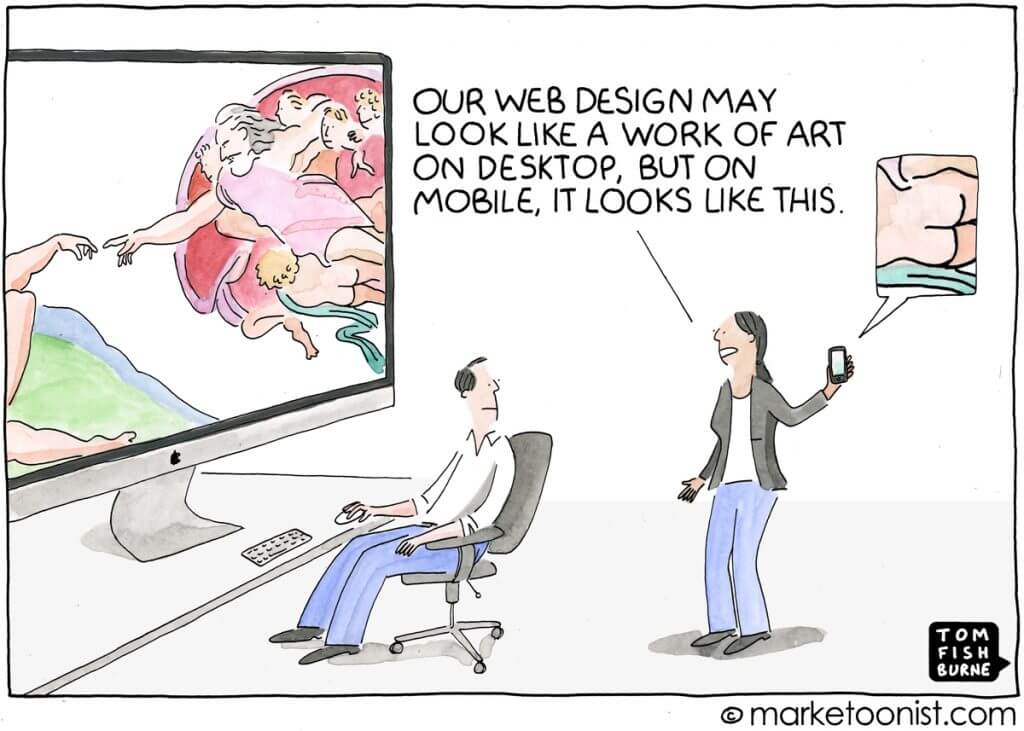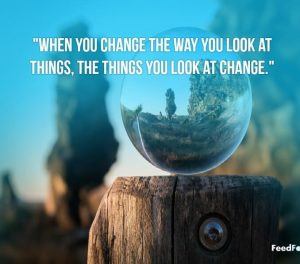 If transformation is due to the change in what you see then the most important thing to change is your view.
If transformation is due to the change in what you see then the most important thing to change is your view.
Your view of anything is what you actually see without resistance. Mostly a tiny bit of what is there… and you base your whole world view on that tiny bit.
Your language, your behavior, your facial expression can reveal the your view of self you are trying to hide.
Your language, the words you use, your tone of voice, reveals your inner coherence, and all the unreality you consider reality, your attitude, your haughtiness, your delusion… everything.
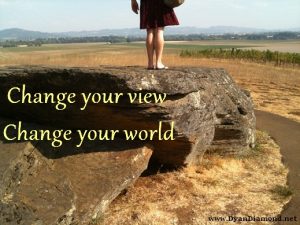 To the person who can read… you are an open book.
To the person who can read… you are an open book.
Why would someone not be able to read you?
They may be too self-absorbed, especially if they have something to hide.
People who have the “foot nailed to the floor” inner dynamic, cannot pay attention outward, they are too busy being concerned.
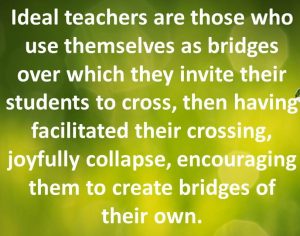 In the Playground, a ground breaking transformational program, we are in the “confront” phase: where we are looking at the inner, hidden dynamic that drives our feelings, our emotions, our behavior, and unless we confront the whole as it is, we can be stuck there.
In the Playground, a ground breaking transformational program, we are in the “confront” phase: where we are looking at the inner, hidden dynamic that drives our feelings, our emotions, our behavior, and unless we confront the whole as it is, we can be stuck there.
Of course every phase is a journey, and everyone on the course is at a different phase, and that is how it should be. The important thing is that you start looking at what you have been hiding, what has maybe even hiding from you.
The ugliness.
We all have it, I have it too.
And what we are interested in is getting to the phase of owning all of ourselves, the good, the bad, and the ugly, so we can be an integrated whole: a person.
Until you become a person, your life is not enjoyable, you don’t love yourself, and you can’t love others.
In this article, I would like to focus on a little known dynamic: your cone of vision.
It is very hard to communicate, so please bear with me.
But unless it is addressed, unless it becomes conscious, nothing lasting, nothing permanent can be achieved, so unless it is made conscious, you are just spinning your wheels, get some good experiences, some passing victories, bragging rights, but not a life worth living.
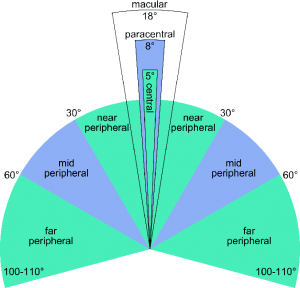 Your eyes see through the pupils, and the size of the pupils is not constant. The shape of your eye balls also change.
Your eyes see through the pupils, and the size of the pupils is not constant. The shape of your eye balls also change.
There are eye muscles that you have never learned to use consciously, even though they can be exercised.
The size of the pupils and the shape of your eyeball, together, determine your cone of vision.
Your cone of vision is the visual field inside which you see things in full color. Outside of your cone of vision you see things in black and white.
What you see in color can be recognized, distinguished, dealt with appropriately. What you see in black and white feels threatening, like ghost coming out of the mist…
The more things happen outside of the cone of vision where things are in color, the more vague fear and terror you experience, and quite counter-intuitively, the eyes constrict your cone of vision more… instead of checking out what it was that was threatening your existence.
When I say existence, I mean the “I want to look good and make it” survival machine. Where not looking good equals a threat to your survival.
It is a machine, it is hard-wired, it is not the enemy. It is what it is. It’s like a car. How you drive it matters more than how the car is… I once raced a car with engine four times bigger than my car’s… and beat it. I was a better driver.
So don’t fight the machine… learn to drive it well.
This principle, by the way, applies to all areas of life with a hidden dynamic, not just the behavior dynamics we learn to “drive” in the Playground. The principle applies to business. To relationships. To your health. To politics. To saving the planet from us, humans.
Every area of life.
The capacity to drive the hidden dynamics of the eyes/vision is a complicated capacity: you have to see it, you have to accurately evaluate it, you have to have a higher purpose, whatever that means in the moment, and operate the eye muscles on demand.
Empaths and sensitives, who can feel others’ emotions, are especially prone to narrow cone of vision: feeling all those emotions around them as their own fills them with fear, and fear makes you feel threatened, and you automatically narrow your cone of vision by the eye muscles.
Threats are many: disapproval, physical violence, being bullied, being called stupid, inferior, being condescended upon, being slighted, being robbed, etc. all lurk in the black and white segment of your vision… they can be real or unreal.
And you deal with all of them with a further narrowing of your vision… resulting in more fear… quite counter-productive.
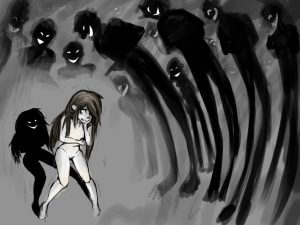 I am an empath, I was physically abused, verbally abused, so by my late 20’s I had a pinpoint of a cone of vision, that to me manifested in agoraphobia: I felt threatened in spaces that were open.
I am an empath, I was physically abused, verbally abused, so by my late 20’s I had a pinpoint of a cone of vision, that to me manifested in agoraphobia: I felt threatened in spaces that were open.
Supermarkets, department stores, large open offices, magazines (with pictures), buildings, streets, lakes and oceans… It was horrible.
It’s like being dizzy all the time.
20 years later, by sheer luck, I met a guy who recommended that I see a behavioral optometrist.
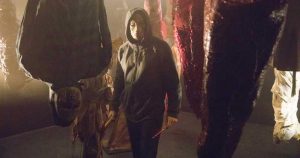 By this time I lived in the third country, and the years marched by like the horrors of the “Hell Fest” rides of the amusement park: it is dark with spotlights on some scary but recognizable stuff… the rest is scary as hell.
By this time I lived in the third country, and the years marched by like the horrors of the “Hell Fest” rides of the amusement park: it is dark with spotlights on some scary but recognizable stuff… the rest is scary as hell.
I spent six months learning to control my eye muscles, synchronize them, flash out my vision, so I can see more of the world in color.
It was expensive, but it was worth it.
At the beginning of the six months my cone of vision was 10 degrees… meaning that I only saw a minuscule part of reality in color. Today it is 30 degrees across now, nine times more than before. We compare the enclosed territory of the circles of vision.
I have an empath student, whose cone of vision is 6 degrees across… which is three times smaller than I had at the beginning of my treatment in 1996…
So I have been observing him to be able to teach. He has learned to flash his eyes out, he learned to return from fear… and yet his natural, resting cone of vision is remaining puny…
I am observing his behavior in different situations, especially in the partner calls…
 Any indication of disagreement or disapproval further narrows his cone of vision, and he start talking really loud, and pompous, haughty, domineering, and threatening… a lot like animals in the wild make themselves look bigger by puffing up their hair… it would be amusing if I didn’t know where it is coming from.
Any indication of disagreement or disapproval further narrows his cone of vision, and he start talking really loud, and pompous, haughty, domineering, and threatening… a lot like animals in the wild make themselves look bigger by puffing up their hair… it would be amusing if I didn’t know where it is coming from.
Compassion is recognizing where the other is, and recognizing that you’ve been there yourself before. You have gotten to the other side. Compassion is offering a helping hand to the other to help them to the other side.
Compassion is not sympathy, not pity, not condescension. Compassion may make your throat tighten, may make you shed some tears, but it’s active. It is a moment where the other person happiness is more or equally important to you than your own.
You don’t make a commitment to love them, you make a commitment in your heart to give them a hand…
Sponsoring in a 12-step program is an actual expression of compassion… When you are in trouble, it is mighty impossible to find your way out of the trouble without help. Without someone’s help who has been there and got through successfully.
I have a student who quit after his wife left him with their five children for some dude she met on a cruise. He used to be an alcoholic, so he returned to what he knew: drinking.
Instead of finding expert help, he is leaning on his 18 year old daughter, who is crushed under the load… who knows nothing of anything… that is the truth about you when you are that young… no exception. Even a 24 year old, my empath student, is largely clueless about life… although probably both the 18 year old and the 24 year old think they already know everything. I remember I did.
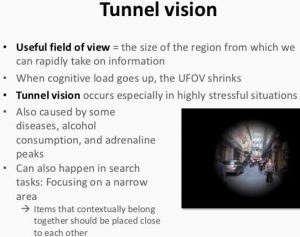 OK, so let’s look at the symptoms, the observable symptoms of a narrow cone of vision, whether it is temporary or chronic.
OK, so let’s look at the symptoms, the observable symptoms of a narrow cone of vision, whether it is temporary or chronic.
1. Inability to see that a momentary inspiration will disappear, consistent with your track record
2. Inability to see that other people may know something that you don’t yet know or have met
3. A rigid insistence on rules
4. Too much talking
5. Giving no respect, real respect to anyone
6. Inability to see value anywhere. No value means also no ambition… what drives ambition is the value you strive for.
7. High desire score in the Starting Point Measurements
8. Sky high about me score (lack of humility) in the Starting Point Measurements.
9. Harsh reaction to anything that questions your knowledge, status, or anything you need to protect
10. Your sky high opinion about yourself (fixed mindset?)
11. Get stuck in unpleasant feelings
The last point is more due to the inability or unwillingness to move your head.
I have learned a trick psychologists use to dislodge stuck states in clients… causing a state change.
Here it goes: you slowly turn your head from center to the left, as far as you can go, eyes open. then all the way to the right, and back to left, and back to right…
Your eyes are open and you see the world change as you move your eyes and your whole head.
The main problem with narrow cone of vision is the fixed view: avoiding seeing anything else.
The world is big. Reality is large… and the context, the connection between things cannot be seen inside a fixed little window… so all your decisions will be based on a partial reality at best.
I love this cartoon: it tells the whole story.
Read the original article: Change your view… change your life
